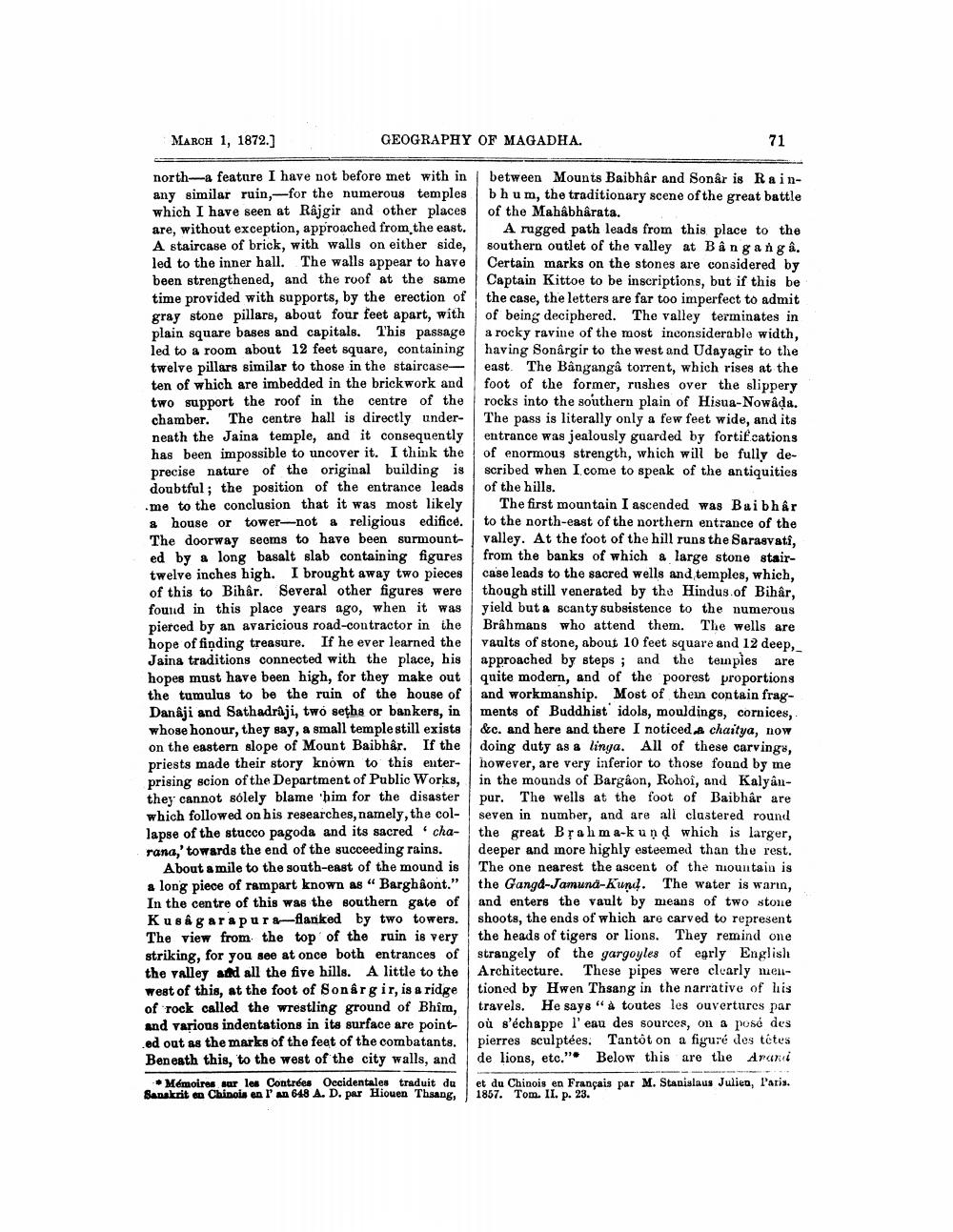________________
MARCH 1, 1872.)
GEOGRAPHY OF MAGADHA.
north-a feature I have not before met with in between Mounts Baibhâr and Sonar is Rainany similar ruin,- for the numerous temples bhum, the traditionary scene of the great battle which I have seen at Rajgir and other places of the Mahabharata. are, without exception, approached from the east. | A rugged path leads from this place to the A staircase of brick, with walls on either side, southern outlet of the valley at Banganga. led to the inner hall. The walls appear to have Certain marks on the stones are considered by been strengthened, and the roof at the same Captain Kittoe to be inscriptions, but if this be time provided with supports, by the erection of the case, the letters are far too imperfect to admit gray stone pillars, about four feet apart, with of being deciphered. The valley terminates in plain square bases and capitals. This passage a rocky ravine of the most inconsiderable width, led to a room about 12 feet square, containing having Sonargir to the west and Udayagir to the twelve pillars similar to those in the staircase- east. The Bangangå torrent, which rises at the ten of which are imbedded in the brickwork and foot of the former, rushes over the slippery two support the roof in the centre of the rocks into the southern plain of Hisua-Nowada. chamber. The centre hall is directly under- The pass is literally only a few feet wide, and its neath the Jaina temple, and it consequently entrance was jealously guarded by fortif cations has been impossible to uncover it. I think the of enormous strength, which will be fully deprecise nature of the original building is scribed when I come to speak of the antiquities doubtful; the position of the entrance leads of the hills. me to the conclusion that it was most likely The first mountain I ascended was Baibhâr 2 house or tower--not a religious edifice. to the north-east of the northern entrance of the The doorway seems to have been surmount- valley. At the foot of the hill runs the Sarasvati, ed by a long basalt slab containing figures from the banks of which a large stone stairtwelve inches high. I brought away two pieces case leads to the sacred wells and temples, which, of this to Bihar. Several other figures were though still venerated by the Hindus.of Bihar, found in this place years ago, when it was yield but a scanty subsistence to the numerous pierced by an avaricious road-contractor in the Brâhmans who attend them. The wells are hope of fiņding treasure. If he ever learned the vaults of stone, about 10 feet square and 12 deep, Jaina traditions connected with the place, his approached by steps; and the temples are hopes must have been high, for they make out quite modern, and of the poorest proportions the tumulus to be the ruin of the house of and workmanship. Most of then contain fragDanaji and Sathadraji, two seths or bankers, in ments of Buddhist idols, mouldings, cornices, whose honour, they say, a small temple still existe &c. and here and there I noticed a chaitya, now on the eastern slope of Mount Baibhâr. If the doing duty as a linya. All of these carvings, priests made their story known to this enter- however, are very inferior to those found by me prising scion of the Department of Public Works, in the mounds of Bargaon, Rohoi, and Kalyanthey cannot solely blame 'him for the disaster pur. The wells at the foot of Baibhâr are which followed on his researches, namely, the col- seven in number, and are all clastered round lapse of the stucco pagoda and its sacred cha- the great Brahma-k und which is larger, rana,' towards the end of the succeeding rains. I deeper and more highly esteemed than the rest.
About a mile to the south-east of the mound is The one nearest the ascent of the niountain is a long piece of rampart known as “ Barghầont." the Ganga-Jamuna-Kund. The water is warın, In the centre of this was the southern gate of and enters the vault by means of two stone Kusagarapur&flanked by two towers. shoots, the ends of which are carved to represent The view from the top of the ruin is very the heads of tigers or lions. They remind one striking, for you see at once both entrances of strangely of the gargoyles of early English the valley and all the five hills. A little to the Architecture. These pipes were clearly menwest of this, at the foot of Sonargir, is a ridge tioned by Hwen Thsang in the narrative of his of rock called the wrestling ground of Bhim, travels. He says" à toutes les ouvertures par and various indentations in its surface are point où s'échappe l'eau des sources, on a posé des ed out as the marks of the feet of the combatants. pierres sculptées. Tantôt on a figuré des tétes Beneath this, to the west of the city walls, and de lions, etc.". Below this are the Arandi
Mémoires sur les Contrées Occidentales traduit du Sanskrit en Chinois en l' an 648 A. D. per Hiouen Thsang,
et du Chinois en Français par M. Stanislaus Juliea, Paris. 1857. Tom. II. p. 23.




